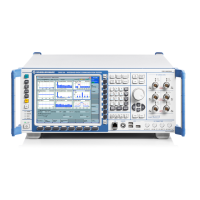System Overview
R&S
®
CMW500
55User Manual 1173.9463.02 ─ 06
External Attenuation (Input)
Defines the value of an external attenuation (or gain, if the value is negative) in the input
path. This is suitable if the test setup contains a frequency-independent attenuating com-
ponent (e.g. a non-ideal cable, a test fixture or an RF shielding chamber used to hold the
DUT), or an amplifier.
Additional settings for compensation of a frequency-dependent attenuation/gain are pro-
vided by the base system of the instrument. They allow to define correction tables con-
taining pairs of frequencies and associated attenuation/gain values.
If a table is activated for an input connector, the correction value associated with the
current carrier frequency and the frequency-independent "External Attenuation" defined
in the measurement settings are added. Correction values for intermediate frequencies
between two frequency entries are calculated using linear interpolation. For frequencies
higher than the highest frequency entry in the table, or lower than the lowest frequency
entry, the correction value associated with the highest / lowest frequency entry is used.
The total correction value (frequency-independent "External Attenuation" + frequency-
dependent correction) modifies the power reading of the measurement and ensures that
the measured powers are referenced to the output of the DUT.
●
Positive values increase the power reading, compensating for an attenuation.
●
Negative values reduce the power reading, compensating for an amplification factor
(gain).
The external attenuation also enters into the internal calculation of the maximum input
power that the R&S CMW500 can measure (see "Expected Nominal Power" below).
Frequency-independent attenuations are defined as part of the measurement settings,
refer to the description of the measurement application. Frequency-dependent correction
tables are administrated and activated/deactivated only via remote commands
(...:FDCorrection:...).
While a correction table is active for the connector currently used by an application, the
GUI of the application displays the table name together with the frequency-independent
attenuation setting.
The table entries can be displayed by clicking the button "FDCorr!".
Expected Nominal Power
Defines the nominal power of the RF signal to be measured. The nominal power should
be set in accordance with the actual transmitter output power of the DUT; an additional
"External Attenuation" (see above) can be used to compensate for the loss in the test
Measurements

